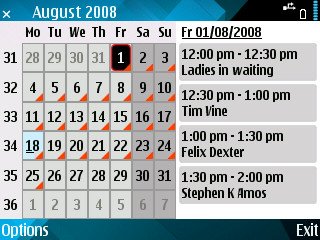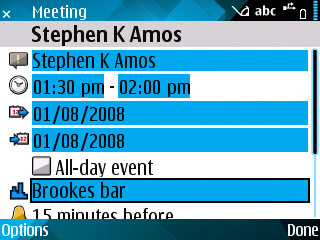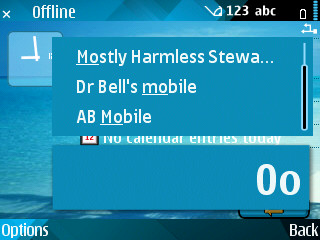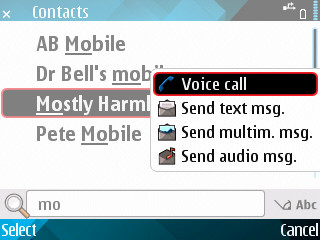Nokia's latest E-Series device, the E71, is a sleek piece of kit, and certainly ticks a lot of boxes for the Enterprise crowd. Much as the E90, many industry watchers are looking at the E71 as 'the' executive phone for the next few years. But once you take it out of a clinical 'let's make sure we review every application and try every function' labs, what is it like in the real world?
I'm currently doing some work at the Edinburgh Fringe (as you may recall), and it's time to take the E71 on a real world test. It might have a bundle of fancy features and gee-whizz for us geeks, but as a tool, how does it work out?

Let's start with something rather surprising - how it looks. The E71 is unnaturally thin for a smartphone, something that Steve touched on briefly in regards to the physical dimensions in his review, but the silvery metallic casing, the blackberry like keyboard, and the bright and gorgeously readable screen has become a magnet for people to ask 'what phone is that?' when I pull out the device around the streets of Edinburgh.
The Fringe is a time when everyone is judging everyone else, and for the E71 to turn heads in a good way is a good sign. Getting smartphones into the hands of users is no longer just a function of good software, everything has to fit together, and in certain circles, the fashion implications of having a good looking phone are more important than the functions. Luckily the E71 manages to cover both bases in the glitz of the Fringe.
The other big thing at Edinburgh is diary management - with some 3000 shows going on, over 25 days, no-one can get round everything, but, in my position, there is a need to get round as many events as possible. On top of that I need to schedule interviews with many of the performers and personalities, which adds another dimension to schedule juggling, and one which tends to be much more dynamic than fixed show times.


My previous experience with the S60 calendar has, like many others, been distinctly lacking. Fortunately Calendar is the application that received the biggest upgrade in the move to the E71. It uses the split screen approach to present information and a smaller font size than earlier devices, which means a lot of information can be seen on the screen at one time.
Quickly flicking between each day provides the snap overview that makes checking the diary while on the phone a matter of "hold on a moment" to the caller, hit the calendar key, and be able to see what times are available in less time than it takes to draw breath. Once the call is finished, it's a matter of heading into the day to add or edit the appointment. Similarly the week view lets see your availability over a period of several days; this is essential when trying to fit one more thing into a packed schedule. The add/edit event dialogs have also been redesigned and 'compressed', which makes it much easier to add or edit entries when on the move. See Steve's E71 review or Rafe's E66 review for more information on this.
Although the underlying functions of the Calendar application haven't really changed, these tweaks in application layout and presentation have made Calendar a lot more useful to me in the fast moving world of Edinburgh. For this update alone, the E71 is worthy update.
The other major feature while out and about is looking up contacts. The thing that I enjoyed most about the E71 was that I don't have to go into the contacts application any more to dial a number. By starting to type in a name (at the Idle screen), you get a list of live search results on the screen. A few key presses (3 or 4 is enough) and you'll be able to scroll up to the name you want and choose whether to make a voice call or send a message. Typing a regular mobile number is the same process, and the software can tell after a few presses if there is a address book match, or if you are wanting a regular number.
This smart dialer is another practical solution that really helps in the real world, and makes the E71 feel less of a 'gadget' and more like a functional tool that can simply get the job done. This feeling is reinforced by numerous other changes through out the E71's software suite - it really does feel like Nokia have listened to its E61 users and made applicable changes to the E71.


There are some missing areas, the messaging client for example, that have not been altered. I'm hoping that this is the area that Nokia turns to for the next major change. Strangely there's little call for SMS or Email at the Fringe; everything runs on phone calls and diaries. Which is coincidentally the major strengths of the E71. Looks like the Enterprise focus, at least in this environment, can be declared a success. I do wonder if my feeling would be so positive if I had needed to deal with email on a regular basis.
A potential stumbling block, for me, was the keypad. The E71 is significantly narrower than the E61 style devices - I was certain this would have a detrimental affect on its performance. However in reality it's not as big a problem as I was expecting. My typing speed, compared to the E61, wasn't reduced significantly. Moreover because the keys are significantly more domed than previous devices I found hitting the correct keys is easier for me on the E71 than the E61 which increased my accuracy.

I doubt that I'd want to do a significant amount of document writing or editing on the E71, but the option is there thanks to the bundled Quickoffice. Since I'm mainly recording audio interviews I've not needed to do a lot of editing of documents on the move. It is do-able though, assuming you are not looking to go much over 300 words or so.
I've found Quickoffice more useful as a read-only tool. The contact details and press releases from PR people, agents and acts were all copied over to the E71 so I could carry them all with me. Quickoffice does a good job rendering the documents and the landscape orientation of the screen is ideal for document viewing.
On top of the PIM software that I'm using heavily, two other applications have been in heavy use around the Fringe, both of which are now included in the firmware. The first is the podcasting application; given that I am doing a daily podcast about the Fringe it's nice to have the files on the handset. It also acts as a nice check that everything is working with the podcast RSS feed. The second application is Nokia Maps v2.0. While I might know my city well, there have been some obscure venues I have had to check the address to find out where they are. I found the map search useful as a native and for anyone else coming to the Fringe it would be invaluable.
The E71 is a great phone for someone out and about at an event like the Edinburgh Fringe. Eyes have been raised at Nokia's strategy of having different devices with different capabilities in a product road map... the Eseries devices are no different in this respect to any others. The E71 sits between the E51 and the powerhouse E90. I think this is something of a sweet spot - for me it is a case of having a relatively small device without compromising on the feature set.
It's definitely a winner as a business/enterprise device, and while it may not win any awards as a multimedia smartphone - the low resolution on the camera and 2.5mm headphone socket stand out as poor performers - it's not going to let you down. This is in sharp contrast to my experience with earlier Eseries devices. This is a phone that can do most things for most people. And do it simply. For me that makes it one of the most appealing enterprise phones currently available.
What has stood out for me, in the real world, as I dash around the Edinbrugh Fringe was that the E71 was a lot more practical than the E90 I used last year. It is a combination of a more pocketable size, the ease of getting to the relevant information, and the good looks. The overriding conclusion? The E71 strikes a very good balance between form and function.
-- Ewan Spence, August 2008
